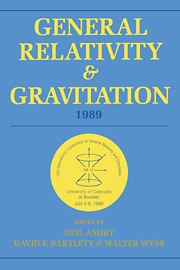 General Relativity and Gravitation, 1989
General Relativity and Gravitation, 1989 Book contents
- Frontmatter
- Contents
- Preface
- Conference committees
- Part A Classical relativity and gravitation theory
- 1 Colliding waves in general relativity
- 2 How fast can pulsars spin?
- 3 Global properties of solutions to Einstein's equations
- 4 Progress in 3D numerical relativity
- WORKSHOPS
- Part B Relativistic astrophysics, early universe, and classical cosmology
- WORKSHOPS
- Part C Experimental gravitation and gravitational wave detection
- WORKSHOPS
- Part D Quantum gravity, superstrings, quantum cosmology
- WORKSHOPS
- Part E Overviews-past, present, and future
2 - How fast can pulsars spin?
Published online by Cambridge University Press: 05 March 2012
- Frontmatter
- Contents
- Preface
- Conference committees
- Part A Classical relativity and gravitation theory
- 1 Colliding waves in general relativity
- 2 How fast can pulsars spin?
- 3 Global properties of solutions to Einstein's equations
- 4 Progress in 3D numerical relativity
- WORKSHOPS
- Part B Relativistic astrophysics, early universe, and classical cosmology
- WORKSHOPS
- Part C Experimental gravitation and gravitational wave detection
- WORKSHOPS
- Part D Quantum gravity, superstrings, quantum cosmology
- WORKSHOPS
- Part E Overviews-past, present, and future
Summary
The upper limit set by gravity on the rotation of neutron stars is sensitive to the equation of state of matter at high density. No uniformly rotating equilibrium can have angular velocity greater than that of a particle in circular orbit at its equator, and, for a given baryon mass, the configuration with maximum angular velocity rotates at this Keplerian frequency. The limiting frequency decreases with increasing stiffness in the equation of state, because (for a given mass) models of neutron stars constructed from equations of state that are stiff above nuclear density have substantially larger radii and moments of inertia than models based on the softer equations of state. While for cold neutron stars the Keplerian frequency is the gravitational limit on angular velocity, for hotter stars (T > 10 K), viscosity is apparently low enough that gravitational instability to nonaxisymmetric perturbations sets in slightly earlier. The corresponding constraint on the equation of state is more stringent; and if the 1968 Hz frequency seen in optical emission from SN 1987A is the angular velocity of a newly formed pulsar, neutron star matter must be unexpectedly soft above nuclear density. Too soft an equation of state, however, cannot support a spherical neutron star with mass as large as the observed 1.44 solar mass member of the binary pulsar 1913+16. A rather narrow range of equations of state survives the two observational constraints.
Quark stars and stars with pion or kaon condensates are possible alternatives.
- Type
- Chapter
- Information
- General Relativity and Gravitation, 1989Proceedings of the 12th International Conference on General Relativity and Gravitation, pp. 21 - 40Publisher: Cambridge University PressPrint publication year: 1990
- 2
- Cited by


